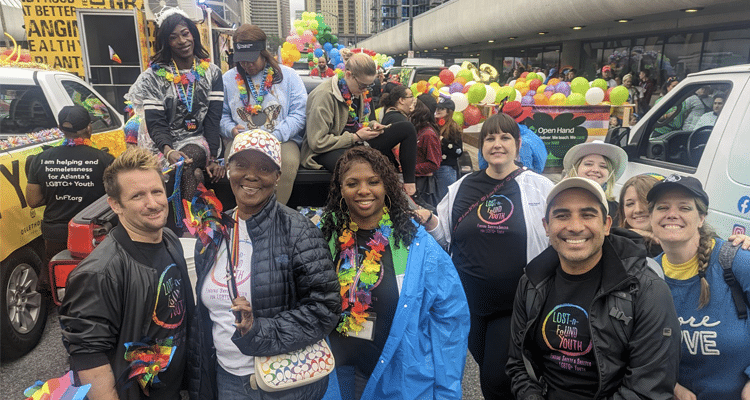A look at LGBTQ youth homelessness
According to the Trevor Project’s “Homelessness and Housing Instability Among LGBTQ Youth” report, 28 percent of LGBTQ youth have experienced homelessness or housing instability at some point in their lives. Compared to the estimated 14 percent of Americans who have experienced homelessness in their lifetimes, queer young people are overwhelmingly more likely to be kicked out of their homes and left with no other options, often disowned for their sexuality or gender identity.
“I have a trans youth that is with us now,” Melanea Alvarez, the Executive Director of Lost-N-Found Youth, told Georgia Voice. “They came to us because their father kicked them out of the house. There were always altercations between them and their father, their father put a restraining order against them, and they left the home and came to us. I have no idea why a restraining order could have ever been placed on this youth. They are the kindest, most understanding [person].”
The same goes for foster care: LGBTQ youth are overrepresented, with 30 percent of youth in the foster system identifying as LGBTQ.
“I was told that foster families didn’t want a gay kid in their home, so I grew up in group homes and residential centers where I was abused sexually, physically, and emotionally,” Kristopher Sharp, a queer young person who spent eight years in foster care, told the Human Rights Campaign for their “LGBTQ Youth in the Foster Care System” report.
For these kids, homelessness can be the expected outcome of aging out of the foster care system – and what they need to thrive in the way they deserve is a lot more than just a place to sleep. These kids need somebody to listen to them, accept them as they are, and help teach them the basic life skills their guardians neglected to teach. What they need is a parent.
LNFY serves as a family for kids who need one. The organization operates from a place of empathy to treat young adults ages 18 to 25 with the respect and support necessary for them to blossom into self-reliant and successful adults.
“Every one of them is unique,” Alvarez said. “Everyone needs something a little different. Maybe some are very aware of what they need, but they just don’t know what resources are available. We have an entire resource guide that we’ve developed inside the drop-in center.”
The drop-in center offers more than just resources: they offer case management and intake for those who need longer-term care; services like showers, lunch, clothing, and employment aid; as well as regularly scheduled events like a psychotherapy group, a faith group, HIV testing and education, and more.
Depending on the level of need, there are seven-day and 90-day housing programs with room for up to 16 people. Each program includes case management, with check-ins and evaluations every 30 days in the longer program. While they are living at LNFY, not only are these young adults getting a warm place to live, they are getting to learn the life skills necessary to live on their own in an environment akin to a family home.
“The parents, whenever they start to sense that there’s something different and because you’re labeled as being different, they just don’t want to focus on you,” Alvarez said. “So, think about life skills: think about things that are as simple as preparing a meal, using the microwave, it could be doing laundry, think about chores around the house, washing dishes, mopping a floor, all those kinds of things that we just take for granted because we have been taught… While the youth are either engaged at our drop-in center or in one of our two houses, we assign them chores, and we actually demonstrate to them the things that they need to do and why it’s responsible. You get that feeling of being not in an institution or a shelter, but you’re surrounded by people like you and you’re in a safe space.”
Support doesn’t end when the 90 days are up; there are aftercare programs with follow-up case management anywhere from one month to a year after their stay. Alvarez says former residents often return to volunteer and connect with the current residents.
Of course, one necessity for ending the cycle of homelessness for anyone is securing employment – which is hard enough as it is but made even more difficult when you don’t even know how to start. Alvarez said she sees some young people who “don’t know the first thing about what to do to search for a job.” That’s where the Job Readiness Program comes in, which teaches employment skills like customer service, problem-solving, punctuality, attendance, accountability, teamwork, sales, and communication. When they complete the program, in which they are paid hourly and may work up to 24 hours a week, they will be connected to a Job Readiness and Development Program Partner for future employment. They also have the opportunity to work in LNFY’s thrift store, which five people are doing now.
“They’re struggling, have anxiety – social anxiety is big, they don’t want to be around crowds,” Alvarez said. “They tend to be introverts, and it’s because they’re insecure. Having the opportunity to employ them in the store gives us an opportunity to stand beside them, mentor them, and give them the awareness that retail can be an amazing thing.”
Learn more about and support Lost-N-Found Youth at lnfy.org.

